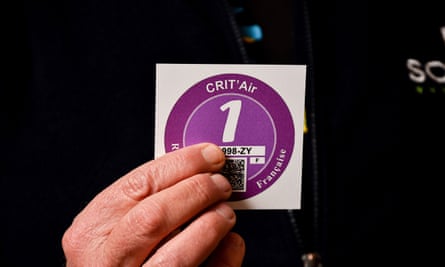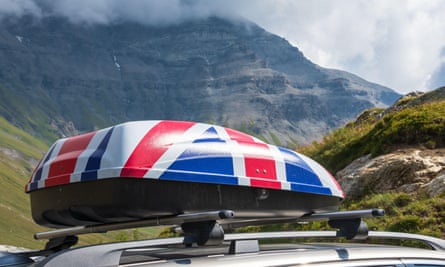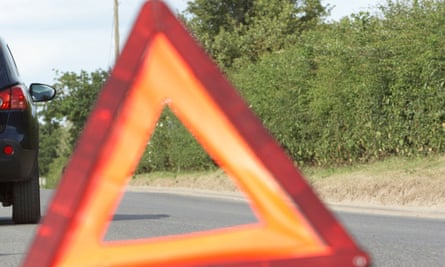
British drivers heading over the Channel have long had to factor in a whole host of extra things to carry, from yellow vests to warning triangles. But how many of those making the trip this summer are aware they will need to display a clean air sticker – called a Crit’Air vignette – if they plan to drive into several French cities?
In a similar move to the clean air and ultra-low emission zones that have sprung up in the UK, the French have at least 12 zones of their own, with more being added all the time.
The big difference between France and the UK is that across the Channel, all cars and motorbikes entering such zones – even those from abroad – need to display a sticker denoting their vehicle’s emissions. Those failing to do so face being fined €68 (£58).
From car insurance to tolls: what Britons need to know before driving to mainland EuropeRead more
If the recent riots haven’t made you rethink your holiday plans, these zones include a number of popular tourist locations, including Paris, Rouen, Strasbourg, Toulouse, Montpellier, Lyon, Grenoble, and a few other cities, where you risk the fine if you don’t display one.
The plan is to eventually have a low emission zone in every urban area with a population greater than 150,000 people, so if you are doing a long French road trip, it’s very much worth getting one.
Those who take the ferry or Eurotunnel and who stay away from any big urban areas, will not be required to display one.
The good news is that the stickers are relatively easy and cheap to obtain, even if it requires a little bit of time and some internet expertise.
UK drivers should log on to the official website Certificat-air.gouv.fr to apply. Beware: there are a number of fake websites that will try to charge you more.
Crucially, owners will need their DVLA V5 document, as they are required to input data, including the vehicle’s VIN, or chassis number, and to upload a photograph of the document as part of the application.
It costs €4.61 including postage, for each vehicle. Once it arrives, users have to put it on the car windscreen, or on the motorbike, and it lasts for the lifetime of the vehicle.
 View image in fullscreenCheck out the regulations before driving in France. Photograph: Pixavril/Alamy
View image in fullscreenCheck out the regulations before driving in France. Photograph: Pixavril/Alamy
Because they are sent by post, and will take a few days to arrive, travellers will ideally apply a couple of weeks before they set off. Buyers report they arrive quickly.
There are six categories in the Crit’Air vignette system, from green for the cleanest vehicles to dark grey for the dirtiest. The certificate you receive relates to your vehicle’s Euro emissions standards. Even if you have a 100% electric car, you need to display the sticker.
Not all vehicles are eligible. Cars registered before January 1997, and motorbikes and scooters registered before June 2000, are not, and cannot be driven at all where restrictions apply – causing a problem for owners of some classic motorbikes and cars.
Local administrations have also outlawed some cars in certain city centres.
Vehicles with lower emissions are given preferential parking and traffic conditions
For example, drivers of older diesel, Crit’Air 4, Euro 3-engined cars – those typically made before 2006 – are banned from much of Paris, Monday to Friday, between 8am and 8pm.
The ban was set to be extended last weekend to include Euro 4 diesel cars (typically 2006-2011) but this was postponed for a second time, until at least 2024.
Vehicles with lower emissions are given preferential parking and traffic conditions.
Holidaymakers may also have to keep their wits about them.
The idea behind these schemes is that local officials can – and do – decide to put short-term limits on the type of vehicles being allowed to enter clean-air zones, if, and when, local pollution levels rise.
 View image in fullscreenThe Crit’Air stickers are colour coded according to the vehicle’s Euro emissions standards. Photograph: SOPA Images/LightRocket/Getty Images
View image in fullscreenThe Crit’Air stickers are colour coded according to the vehicle’s Euro emissions standards. Photograph: SOPA Images/LightRocket/Getty Images
That said, the owners of most UK cars that are less than 12 years old will receive a Crit’Air rating of 1 or 2, and should face relatively few restrictions.
According to the RAC, the Crit’Air vignette is just the latest item to add to your list of things to take when driving your car abroad.
The RAC Europe spokesperson, Rod Dennis, says he expects the rules to get tighter over the next few years, with all but zero-emission vehicles eventually banned from some city centres.
“Any driver not displaying a sticker, or driving a noncompliant vehicle into a low-emissions zone, runs the risk of a fine. These are currently set at €68, and are issued to drivers by local police officers.
“However, maximum fines will rise to €750 once camera-based enforcement begins, which could be as early as next year.”
 View image in fullscreenHave you checked what you need to carry in your vehicle when abroad? Photograph: Elena Dijour/Alamy
View image in fullscreenHave you checked what you need to carry in your vehicle when abroad? Photograph: Elena Dijour/Alamy
Dennis adds: “Drivers visiting cities in other European countries, including Spain, Italy and Switzerland, also need to do their homework on low emission zones before they take their trip.”
As well as their passport, the RAC advises drivers to carry their V5 ownership document and national insurance number.
If travelling to an EU country or Andorra, Bosnia, Liechtenstein, Norway, Serbia or Switzerland, drivers do not need to carry an insurance green card for their vehicle or trailer or caravan but they should have their insurance certificate.
Drivers do not need an international driver’s permit in the EU, Switzerland, Norway, Iceland or Liechtenstein, as long as they have a photocard driving licence issued in the UK.
 View image in fullscreenWarning triangles are compulsory when driving in France. Photograph: MBI/Alamy
View image in fullscreenWarning triangles are compulsory when driving in France. Photograph: MBI/Alamy
The UK government says they may need an IDP to drive in some EU countries and Norway if they have a paper driving licence. It advises checking with the embassy of the country.
Once you have all the right documents, there are a few other things to factor in. Since September 2021, UK cars have been required to show a UK, rather than GB, sticker.
The AA says that in some countries, such as Spain, Cyprus or Malta, drivers must display an actual UK sticker rather than simply having UK on a number plate.
You are also likely to need a hi-vis yellow jacket in case you break down and have to get out of the car on a busy road. The number is different around Europe but in France you are supposed to carry at least one.
It is a similar story for warning triangles and first-aid kits. In France, the former is compulsory.
This article was amended on 24 July 2023. When driving in France it is compulsory to carry at least one hi-vis vest; not one for each occupant. Also, first-aid kits are not compulsory in France as stated in an earlier version.



